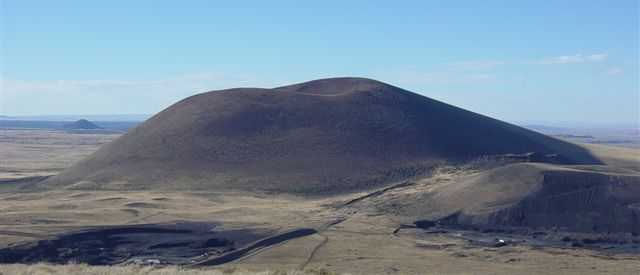Grand Falls of the Little Colorado River
At 185' - 190' (56.4 m - 57.9 m), Grand Falls is higher than Niagra Falls. The Falls is deafening, and spectacularly muddy, during spring snow-melt in the distant White Mountains, and during the monsoon, hence its nickname Chocolate Falls. But it trickles much of the time with little flow over the falls, and is relatively dry during the hot summer months in the high Arizona desert. A short trail leads down to the base of the waterfall. It is an easy trail to the bottom, and gives a different perspective of the waterfall from close-up. If the river current is gentle and the water is not too muddy, there might be a nice pool for wading at the base of the falls. To get a feel for the size of the falls, note the vehicles, people, and shaded picnic tables in the photos.
Recently, Navajo Nation began requiring a $5 (subject to change) hiking permit for non-Navajos to visit Grand Falls, as is usually required for non-Navajos when off-highway inside Navajo Nation for hiking/backpacking, camping, and at Navajo Nation Tribal parks.

About 150,000 years ago, a lava flow from nearby Merriam Crater dammed the Little Colorado, forcing it around the blockage and creating Grand Falls. The Blockage view satellite image clearly shows the lava-flow blockage. Grand Falls is undeveloped other than picnic tables, and is not generally considered to be a tourist attraction. Grand Falls is on bumpy dirt roads (+/- 30 miles), isolated in the high southwestern desert inside the southwest corner of Navajo Nation near Flagstaff, Arizona, but may easily be found by following the maps and directions here or at Navajo Parks and Recreation.
The Little Colorado is an interesting study. It begins at Mount Baldy in the White Mountains at elevation 10,000 ft (3,048 m) and flows northwest for 315 miles (507 km) to the Colorado River in the Grand Canyon at elevation 2,700 ft (823 m). It wanders north along the eastern edge of the Mogollon Rim, then turns around abruptly as it flows south into the Colorado River. It has not always been so dry - three dams far upstream capture much of the snow-melt and upstream tributaries for irrigation. It flows through many canyons and gorges until reaching Cameron at US89. For the final 40 miles or so it flows through the pristine and very deep Little Colorado River Gorge.
The Photo Gallery features six photos of Grand Falls at varying flows with an auto-show of the photos.
Blockage view shows lava-flow blockages with an empty canyon.
Map & Directions is a Google satellite map pinpointing Grand Falls with roads and driving instructions.
